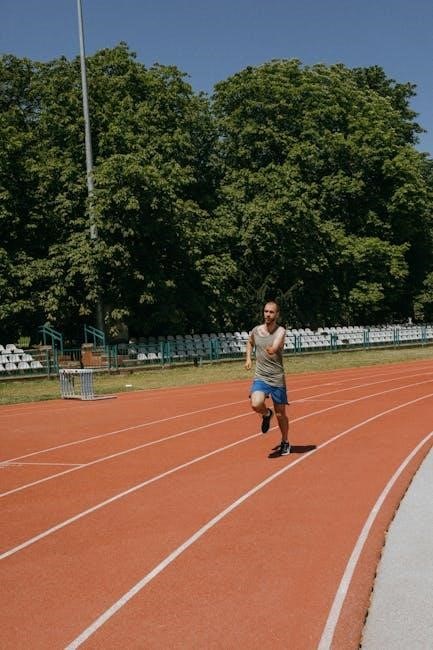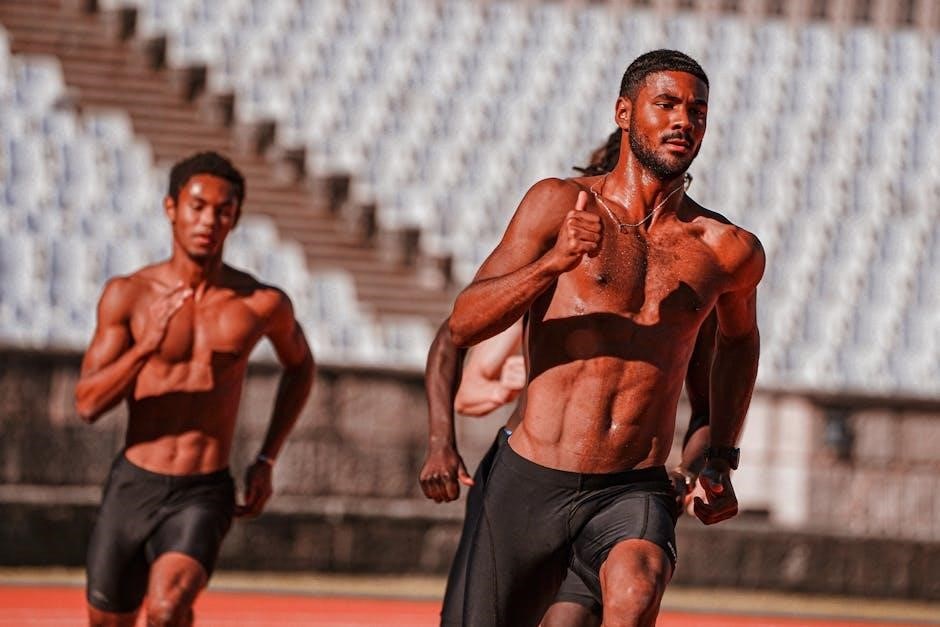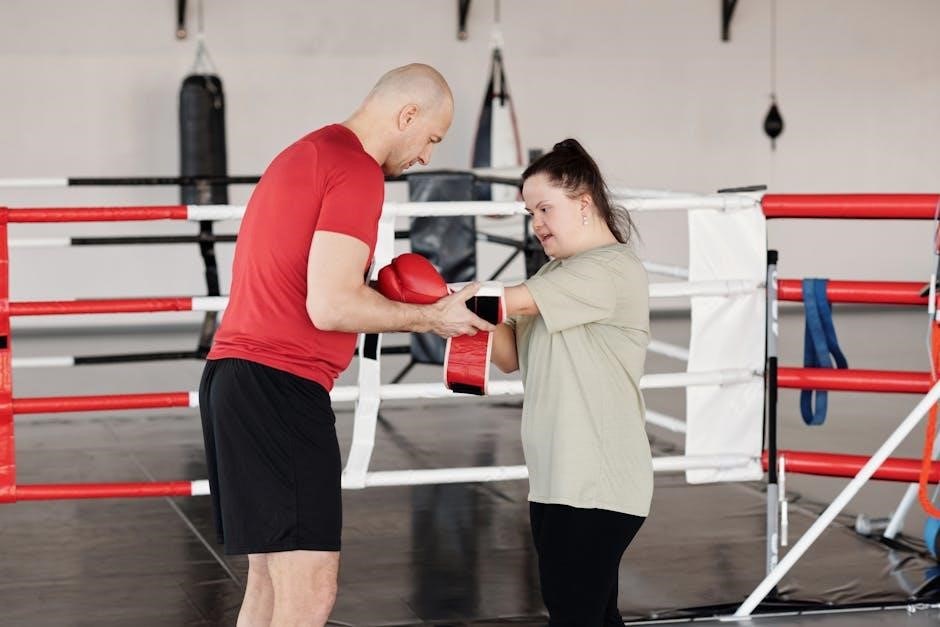This comprehensive guide provides a structured approach to improving 100m sprint performance through targeted speed‚ strength‚ and technique training‚ ensuring optimal results.
Overview of the Training Program
The training program is designed to enhance speed‚ strength‚ and technique for 100m sprinters. It includes a structured 4-week plan‚ starting with foundation building in Week 1‚ focusing on pulling strength‚ upper body conditioning‚ acceleration‚ and power. Week 2 emphasizes endurance and power‚ while Week 3 concentrates on technique refinement and acceleration. The final week prepares athletes for race conditions‚ maximizing speed and mental readiness. The program integrates strength training‚ plyometrics‚ and recovery strategies‚ ensuring a balanced approach to improve performance. Each phase builds progressively‚ allowing athletes to adapt and improve efficiently‚ with clear goals for each session to achieve peak performance by the end of the program.
Importance of a Structured Training Plan
A structured training plan is essential for achieving peak performance in the 100m sprint. It ensures a systematic approach to building strength‚ endurance‚ and technique‚ preventing random and ineffective training. By following a well-designed program‚ athletes can progressively overload their bodies‚ leading to consistent improvements in speed and power. A structured plan also helps avoid injuries by balancing intensity with recovery‚ ensuring long-term progress. Without a clear plan‚ progress can be inconsistent and inefficient‚ making it difficult to reach optimal performance levels. A structured approach provides focus‚ accountability‚ and a roadmap to success‚ making it indispensable for competitive sprinters aiming to excel in the 100m dash.
Key Components of a Sprinter’s Workout
A sprinter’s workout is built around essential elements that target speed‚ power‚ and technique. Speed work‚ including sprints and intervals‚ is fundamental to improving raw velocity. Strength training‚ such as squats‚ lunges‚ and plyometrics‚ enhances muscular power and explosiveness. Technique drills‚ like high knees and butt kicks‚ refine running form to maximize efficiency. Flexibility and mobility exercises are crucial for maintaining range of motion and preventing injuries. Proper warm-ups and cool-downs ensure readiness for training and aid recovery. These components work synergistically to enhance performance‚ making them indispensable for a 100m sprinter’s success. Each element must be integrated thoughtfully to achieve optimal results and peak performance on the track.

Understanding the Basics of Sprinting
Sprinting involves short‚ intense bursts of speed‚ requiring precise technique and explosive power. It combines strength‚ flexibility‚ and coordination to achieve maximum velocity in acceleration and deceleration phases.
Physiology of Sprinting
Sprinting relies heavily on the body’s ability to generate explosive power through rapid muscle contractions. Fast-twitch muscle fibers dominate in sprinters‚ enabling quick‚ powerful movements. The energy system utilized during sprints is primarily anaerobic‚ with the ATP-PC system providing immediate energy for the first 10 seconds. As the race progresses‚ anaerobic glycolysis takes over to sustain effort. Proper neural activation ensures efficient muscle recruitment patterns‚ while elastic energy storage in muscles and tendons enhances performance. A well-conditioned cardiovascular system supports recovery between efforts‚ making it crucial for overall sprint performance and endurance. Understanding these physiological mechanisms is key to optimizing training programs for 100m sprinters.
Biomechanics of Proper Running Form
Proper running form is essential for maximizing speed and efficiency in sprinting. A sprinter’s posture should be upright‚ with a slight forward lean to reduce air resistance and optimize power transfer. Foot strike should be midfoot or forefoot to minimize ground contact time and enhance explosiveness. Limb alignment is critical‚ with legs and arms synchronized to maintain rhythm. The hips and shoulders should rotate to generate additional force and lengthen stride. Proper biomechanics reduce energy waste‚ improve performance‚ and lower injury risk. Coaches often analyze sprinters’ techniques to refine their movement patterns and ensure every muscle contributes effectively to propulsion. Technique mastery is vital for elite-level sprinting success.
Role of Speed‚ Strength‚ and Technique
Speed‚ strength‚ and technique are the cornerstone of a successful 100m sprinter’s performance. Speed determines the ability to cover the distance quickly‚ while strength provides the power needed for acceleration and maintaining top velocity. Technique ensures efficiency‚ reducing energy waste and enhancing performance. A well-balanced integration of these elements allows sprinters to optimize their race execution. Strength training builds muscular power‚ speed drills improve neuromuscular coordination‚ and proper technique minimizes injuries. Together‚ they create a cohesive system that maximizes a sprinter’s potential‚ enabling them to explode off the blocks‚ maintain acceleration‚ and cross the finish line with precision and power.

Sample 4-Week Training Program for 100m Sprinters
This structured program includes weekly focuses: Week 1 builds foundational strength and speed‚ Week 2 enhances power and endurance‚ Week 3 refines acceleration and technique‚ and Week 4 maximizes race readiness.
Week 1: Building Foundation Strength and Speed

This initial week focuses on establishing a strong base of strength‚ speed‚ and endurance. It includes dynamic warm-ups‚ resistance training‚ and short sprint intervals. Strength sessions target the lower body‚ core‚ and upper body‚ using exercises like squats‚ lunges‚ and pull-ups. Speed work involves 20-50m sprints at 80-90% intensity‚ with adequate recovery between sets. Technique drills‚ such as high knees and butt kicks‚ improve running form. Mobility exercises are incorporated to enhance flexibility and prevent injuries. The goal is to build a solid foundation for more intense training in the coming weeks while ensuring proper recovery and adaptation.
Week 2: Enhancing Power and Endurance
This week shifts focus to increasing power and endurance‚ building on the foundation established in Week 1. Sprinters engage in plyometric drills like box jumps and burpees to improve explosiveness. Endurance is developed through longer runs and interval training‚ such as 200-400m repeats at high intensity with short recovery periods. Strength training becomes more dynamic‚ incorporating weighted exercises like deadlifts and bench presses to enhance muscle power. Technique refinement continues with resisted sprints and uphill runs to improve running mechanics. Mobility and recovery remain priorities‚ with stretching and foam rolling to maintain flexibility and reduce muscle soreness.
Week 3: Focusing on Acceleration and Technique
This phase intensifies acceleration training and refines sprinting mechanics. Sprinters perform short‚ explosive sprints (20-50m) at maximum effort to improve acceleration. Hill sprints and resisted runs using bands or weights enhance drive phase efficiency. Technique drills‚ such as high knees and butt kicks‚ focus on proper posture‚ arm swing‚ and leg turnover. Video analysis is used to correct form and optimize performance. Core and stability exercises‚ like plank variations‚ strengthen the lower back and pelvis‚ reducing injury risk. Active recovery includes light swimming or cycling to maintain mobility without overtaxing muscles. Proper nutrition is emphasized to fuel intense workouts and support recovery.
Week 4: Maximizing Speed and Race Preparation
This final week focuses on refining speed and simulating race conditions. Training volume is reduced to avoid fatigue‚ while intensity remains high. Sprinters perform 60-100m sprints at maximum velocity to fine-tune explosiveness and maintain speed endurance. Technique drills‚ such as block starts and flying sprints‚ are emphasized to perfect race execution. Active recovery‚ including light swimming or cycling‚ is prioritized to ensure freshness. Nutrition is optimized for energy and recovery‚ and mental preparation strategies‚ like visualization‚ are introduced to build race-day confidence. The goal is to peak physical and mental performance‚ ensuring athletes are fully prepared for competition.

Building a Personalized Training Plan
A personalized training plan for a 100m sprinter involves assessing fitness levels‚ setting realistic goals‚ and integrating flexibility exercises. Tailor workouts to individual needs.
Assessing Current Fitness Levels
Evaluating an athlete’s current fitness is crucial for creating an effective training plan. Assess speed‚ strength‚ and technique through specific tests like 40m sprints‚ vertical jumps‚ and technique drills. Measure endurance with a 400m run to gauge aerobic capacity. Body composition and flexibility are also key‚ using methods like body fat percentage and range of motion tests. These assessments help identify strengths and weaknesses‚ ensuring the program targets areas needing improvement. Regular testing ensures progress tracking‚ allowing adjustments to maintain optimal development. This data-driven approach ensures a personalized and efficient path to enhancing sprint performance.
Setting Realistic Goals and Milestones

Setting realistic goals and milestones is essential for a structured sprint training program. Start by defining specific‚ measurable‚ and achievable objectives aligned with the athlete’s current fitness level and aspirations. Break down long-term goals‚ such as improving 100m race time‚ into smaller‚ manageable milestones‚ like weekly speed improvements. Use the SMART goal framework to ensure targets are clear and time-bound. Regularly monitor progress and adjust goals based on performance and feedback. Celebrate milestones to maintain motivation‚ ensuring the athlete stays focused and committed to their development. This structured approach helps build confidence and ensures steady progress toward peak performance.

Integrating Flexibility and Mobility Exercises
Flexibility and mobility exercises are crucial for sprinters to maintain optimal performance and prevent injuries. Incorporate dynamic stretches like high knees‚ butt kicks‚ and leg swings to improve joint mobility and muscle activation. Static stretches‚ such as hamstring and hip flexor stretches‚ should be done post-workout to enhance flexibility. Mobility drills‚ including lunges and arm circles‚ help maintain proper movement patterns. Dedicate 15-20 minutes daily to these exercises‚ ensuring smooth transitions between training phases. Proper technique is key to avoid overstretching or strain. By prioritizing flexibility and mobility‚ sprinters can maintain efficient running mechanics‚ reduce injury risk‚ and sustain peak performance throughout the season.

Role of Plyometrics in Sprint Training
Plyometrics enhance explosive power‚ speed‚ and acceleration by improving neuromuscular coordination and muscle reactivity. Essential for sprinters‚ it bridges strength and speed‚ optimizing performance and race readiness.
Benefits of Plyometric Exercises
Plyometric exercises are crucial for sprinters as they enhance explosive power‚ neuromuscular coordination‚ and muscle reactivity; They improve power output‚ enabling faster acceleration and maintaining top speed. Plyometrics also boost stride length and frequency‚ key for sprint performance. Additionally‚ they strengthen muscles and connective tissues‚ reducing injury risk. Regular plyometric training enhances overall athleticism and power‚ giving sprinters a competitive edge. These exercises are efficient‚ combining strength and speed work to maximize training time. By incorporating plyometrics‚ sprinters can achieve faster times and better overall performance in the 100m dash.
Key Plyometric Drills for Sprinters
Essential plyometric drills for sprinters include box jumps‚ depth jumps‚ burpees‚ and bounding exercises. Box jumps enhance explosive power by jumping onto elevated platforms. Depth jumps involve stepping off a platform and immediately jumping upward‚ improving reactivity. Burpees combine strength and speed‚ engaging the entire body. Bounding exercises‚ such as stride jumps‚ focus on maximizing stride length and explosiveness. These drills improve power‚ speed‚ and neuromuscular coordination‚ which are critical for sprinting. Incorporating these exercises into a 100m sprinter’s workout program enhances acceleration‚ top-end speed‚ and overall performance while reducing injury risk through strengthened muscles and connective tissues.

Progressing Plyometric Workouts Safely
Progressing plyometric workouts safely involves a gradual increase in intensity‚ volume‚ and complexity to avoid injury. Start with basic exercises like box jumps and depth jumps‚ ensuring proper technique is mastered before advancing. Increase height‚ distance‚ or repetitions as strength and explosiveness improve. Incorporate variations like single-leg jumps or lateral bounds to enhance adaptability. Warm up thoroughly with dynamic stretches and light cardio to prepare muscles. Listen to your body and rest when needed. Work with a coach to tailor progressions to your fitness level and goals. This structured approach ensures continuous improvement while minimizing the risk of overtraining or injury‚ keeping workouts effective and safe.
Strength Training for Sprinters
Strength training enhances muscle power‚ speed‚ and endurance. Focus on exercises like squats‚ deadlifts‚ and lunges to build lower-body strength. Use resistance bands and plyometrics to improve explosiveness. Ensure proper form to prevent injuries and maximize results. Incorporate core workouts for stability and overall athletic performance. Progress gradually to avoid overtraining. Strength training is essential for sprinters to achieve peak performance and maintain consistency during races.
Essential Strength Exercises
For a 100m sprinter‚ essential strength exercises focus on building power‚ speed‚ and endurance. Squats and lunges target the legs and glutes‚ improving explosiveness. Deadlifts strengthen the posterior chain‚ crucial for acceleration. Bench presses and pull-ups enhance upper-body strength‚ aiding in maintaining proper form. Step-ups and calf raises improve balance and ankle strength‚ reducing injury risk. Medicine ball throws and resistance band work simulate sprinting movements‚ boosting power output. These exercises should be performed with proper form and progression to maximize benefits and prevent overtraining. Incorporating these into a structured routine ensures a well-rounded strength base for optimal sprint performance.
Periodization of Strength Workouts
Periodization of strength workouts involves organizing training into specific phases to maximize performance. For 100m sprinters‚ this typically includes a foundation phase focusing on building general strength‚ followed by a strength phase with heavier loads to enhance power. A power phase incorporates explosive movements like plyometrics and resistance training. Finally‚ a taper phase reduces volume while maintaining intensity to ensure peak performance for race day. Each phase lasts 4-6 weeks‚ allowing progressive overload and adaptation. Proper periodization prevents overtraining‚ ensures injury resilience‚ and aligns strength gains with the competitive season. This structured approach optimizes power‚ speed‚ and endurance for sprinters.
Balancing Strength and Speed Training
Balancing strength and speed training is crucial for 100m sprinters to optimize performance without overtraining. Strength workouts build muscle power‚ while speed training enhances neuromuscular coordination. A well-structured program allocates specific days for strength exercises‚ such as squats and lunges‚ and separate days for speed drills‚ like sprints and plyometrics. This balance ensures athletes develop both muscular force and explosive acceleration. Overemphasizing strength can lead to unnecessary muscle mass‚ while focusing solely on speed may limit power output. A balanced approach allows sprinters to maintain efficiency‚ avoid injury‚ and peak for competition. Periodic deload weeks further help in recovery and sustained progress. This integration is key to achieving elite-level performance.

Proper Warm-Up and Cool-Down Routines
A proper warm-up includes dynamic stretches‚ light cardio‚ and mobility exercises to prepare muscles and enhance performance. A cool-down with static stretches aids recovery and flexibility‚ supporting sprint performance and overall well-being.
Dynamic Warm-Up Exercises
Dynamic warm-up exercises are essential for sprinters to prepare the body for high-intensity efforts. These movements‚ such as high knees‚ butt kicks‚ leg swings‚ and lunges‚ improve blood flow and muscle activation. They mimic sprinting motions‚ enhancing flexibility and neuromuscular coordination. Incorporating dynamic stretches like arm circles and torso twists further prepares the upper body. A 10-15 minute dynamic warm-up increases muscle temperature‚ reducing injury risk and optimizing performance. Proper execution ensures muscles are ready for explosive movements‚ making it a critical component of a sprinter’s routine.
Post-Workout Stretching Techniques
Post-workout stretching is crucial for sprinters to enhance recovery‚ improve flexibility‚ and reduce muscle soreness. Focus on static stretches targeting key muscle groups like hamstrings‚ quadriceps‚ and hip flexors. Hold each stretch for 20-30 seconds to maximize relaxation. Incorporate calf stretches to address tightness in the lower legs‚ often strained during sprints. Additionally‚ stretch the lower back and glutes to maintain proper posture and reduce tension. Perform these stretches within 10-15 minutes after training when muscles are warm. Consistent post-workout stretching helps improve range of motion and supports long-term performance gains‚ making it a vital component of a sprinter’s daily routine.
Recovery Strategies for Optimal Performance
Effective recovery is vital for sprinters to replenish energy‚ repair muscles‚ and enhance performance. Prioritize adequate sleep‚ aiming for 7-9 hours nightly‚ to support muscle regeneration and mental recovery. Proper nutrition‚ including a balanced diet rich in protein‚ carbohydrates‚ and antioxidants‚ aids in muscle repair and energy restoration. Hydration is crucial‚ so drink plenty of water and consider electrolyte-rich beverages to replenish lost salts. Incorporate foam rolling and gentle stretching to reduce muscle tension and improve circulation. Additionally‚ techniques like compression garments‚ ice baths‚ or contrast showers can help minimize muscle soreness. Allow rest days or engage in light activities like swimming or cycling to promote active recovery without overexertion.
